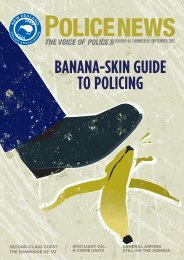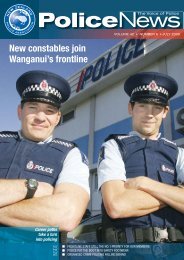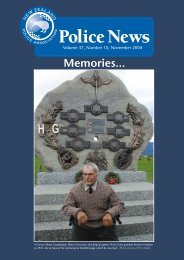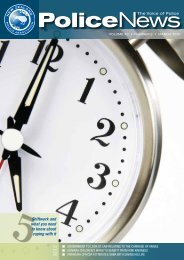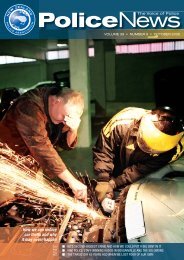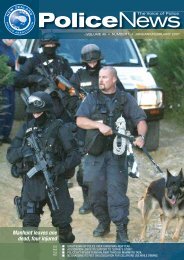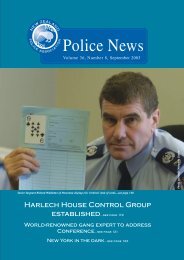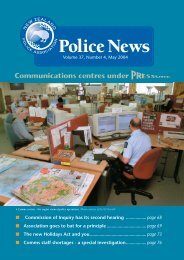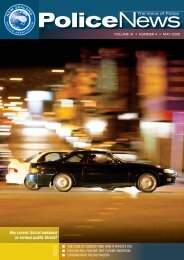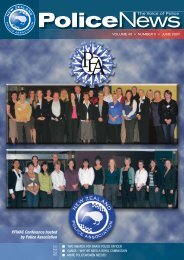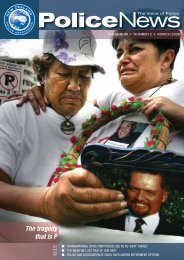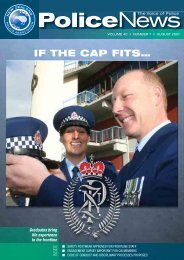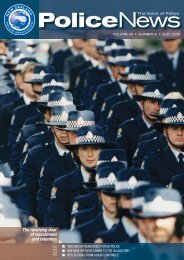<strong>No</strong>vember 2002These are the key resolutions. They do not include all theresolutions nor the administrative resolutions. For a fuller list ofthe resolutions, see our website www.policeassn.org.nzAUCKLAND STAFFING ISSUEMOVED Mr Matthews seconded Mr Cornell that this Conferencecalls upon Commissioner to adopt a $2500 retention allowancepayable from July 2003 to existing <strong>Police</strong> Officers in AucklandCity and Counties/Manukau Districts in recognition of:1) The working difficulties of living and working in thesedistricts.2) The need to ensure that the existing low level of operationalexperience is not further reduced.The ongoing payment of the retention allowance to be assessedannually. Conference also calls upon the Commissioner to assessthe current state of <strong>No</strong>rth Shore/Waitakere Districts in relation tothe Auckland City and Counties/Manukau Allowance. CARRIEDThe minutes are to reflect that <strong>No</strong>rth Shore and Waitakere Districtsvoted against this motion.IDENTITY PROTECTION FOR POLICE OFFICERSMOVED Mr Rowe seconded Mr Lochrie that this Conferenceinstructs National Office to lobby government for the necessarylegislative protection for police officers involved in the use oflethal force and/or serious injury to protect their identity and toprotect them from private prosecution where a properlyconducted enquiry has found they acted lawfully. CARRIEDSTAFFING LEVELSMOVED Mr Lochrie seconded Mr McFadyen that the <strong>Police</strong><strong>Association</strong> establish a strategic plan to research andinvestigate to establish an adequate number of staff required topolice this country and plan a strong and sustained publiccampaign timed to coincide with the build up to the 2005general election.CARRIED154<strong>New</strong> <strong>Zealand</strong> <strong>Police</strong> <strong>Association</strong> <strong>New</strong>sletter<strong>Association</strong> Annual Conference 2001-2002“Crime Costs”The <strong>Police</strong> <strong>Association</strong>’s 67th Annual Conference opened withMP Winnie Laban, speaking for <strong>Police</strong> Minister, GeorgeHawkins who had been detained in the House. The greatachievement of police over the past year resolving a numberof high profile cases was acknowledged, along with the tragicloss of Duncan Taylor, the issues surrounding Auckland andthe burgeoning methamphetamine problem. Conference wasadvised a report on Auckland had been requested from theCommissioner and that the Government shared <strong>Association</strong>concerns over methamphetamine, with legislation changesunderway to reclassify the drug as class A.<strong>Police</strong> <strong>Association</strong> President, Greg O’Connor, followedsaying after the <strong>Association</strong> warning of the methamphetamineproblem since 1997, he was pleased that the resolutionconference passed last year to lobby to have the drugreclassified allowing for increased penalties and searchwithout warrant, looked likely to come to fruition.Greg also attributed the current method of funding <strong>Police</strong>,with top-down imposed output demands, as a real problem,challenging the government to invest in police, but to givethem the flexibility to spend the money in areas where it isneeded most. On their part, <strong>Police</strong> administrators needed astrategy to reduce crime, focusing on crime prevention andreduction and avoiding investment in philosophies and fads.Commissioner of <strong>Police</strong>, Rob Robinson, ticked-off a numberof things that had been or were being worked on includingthe sworn code of conduct, which he said would assist staff to9-11 October 2002ANNUAL CONFERENCE RESOLUTIONSbe clear on the standard expected of them and where theystood, should they not come up to scratch. He alsoacknowledged that the difficult and drawn out saga withConstable A, reassuring delegates that where an officer actslawfully, in a similar situation every type of support would beforthcoming. When questioned regarding legislativeprotection of an officer’s identification and protection fromprivate prosecution, the Commissioner said he believedofficers deserved some protection, which included legalchanges. The law paper prepared by the <strong>Association</strong> on thisissue and provided to police was acknowledged.Andrew Grant, leader of McKinsey and Coy NZ, spoke todelegates of how police needed good leaders and what madegood leaders. He discussed the three components being: Anability to staunchly accept reality; A way to find a deepersense of meaning in the work you do and pass this on toothers; Being prepared to improvise.Dr Chris Wilkins, from the centre for Social and HealthOutcomes Research and Evaluation (SHORE), MasseyUniversity, presented some startling statistics onmethamphetamine and amphetamine type substances (seepage opposite).Tim Mueller, <strong>New</strong> York and Jersey Port Authority <strong>Police</strong>Officer, brought home to Conference Delegates thedevastation and loss of <strong>New</strong> York World Trade Centre terroristattack. The <strong>New</strong> York and Jersey Port Authority, lost 37 policeofficers in the terrorist strike (see page 156).SAR & SPECIALIST SQUAD MEMBERSMOVED Mr Prior seconded Mr Hall that this Conference directsNational Office to assist immediately Search & Rescue and otherspecialist squad members in resolving their claims surroundingeligibility for standby entitlements in order to gain parity withAOS/STG/PNT in respect to the competency payment. CARRIEDRURAL HOUSINGMOVED Mr Price seconded Mr Aberhart that the issue of <strong>Police</strong>Housing is urgently reviewed by the Department in consultationwith the members affected and the <strong>Association</strong>, to focus onequality and fairness.CARRIEDRURAL SURVEYMOVED Mr Price seconded Mr Stokes that this Conference callsupon the Office of the Commissioner to expedite the analysis ofthe rural survey and addressing, in a practical way, the issuesraised by the survey as soon as possible.CARRIEDGSF TRANSFER PROPOSALMOVED Mr Ridley seconded Mr Rudolph that :• Conference endorses the proposal in principle.• The GSF transfers proposal as tabled at the 2002 <strong>Association</strong>Conference be circulated and consulted amongst affectedmembers with District Committees to provide feedback by11 <strong>No</strong>vember.• Conference requests that the NZ <strong>Police</strong> and Governmentafford the highest priority to the resolution of this longstanding but important issue.CARRIEDANONYMITY PROTOCOLMOVED Mr Lek seconded Mr Ridley that Conference instructsNational Office to continue dialogue with the Department to putin place a protocol to guarantee anonymity of members betweenthe time they first become the subject of a criminal investigation,up until the time of their first appearance at court. CARRIED
<strong>New</strong> <strong>Zealand</strong> <strong>Police</strong> <strong>Association</strong> <strong>New</strong>sletter<strong>No</strong>vember 2002MethEdemic - the statistics tell a sobering tale• In the first six months of 2002, Customsseized double the amount of ecstasythat was seized during the whole of lastyear.• By the end of August 2002, <strong>Police</strong> haddetected nearly double the number ofclandestine drug laboratories producingamphetamines compared to last year.• <strong>No</strong>n-cannabis related drug offences,which include Amphetamine TypeSubstance (ATS) offences, increased by34% compared to the previous year.The statistics presented by Dr ChrisWilkins from the Centre for Social andHealth Outcomes Research and Evaluation(SHORE), Massey University to the recent<strong>Association</strong> National conference, tell asobering tale.What Are AmphetamineType Substances?Amphetamine Type Substances (ATS) arederivatives of amphetamine, likemethamphetamine, crystalmethamphetamine and amphetamineanalogues, such as ecstasy.Methamphetamine, (commonly knownas ‘speed’ or ‘meth’) is a powerfulpsychostimulant with characteristics andeffects that closely resemble cocaine.Dr Wilkins said that there had been testswhere heavy cocaine users had beengiven methamphetamine and were unableto distinguish the difference.The onset is slower and duration is longerthan the amphetamine sulphates (mostlydiet pills) which were commonlyencountered in the 1970’s.Crystal Methamphetamine, (commonlyknown as ‘ice’ or ‘crystal’, known in NZ as‘pure’ or ‘P’) is the crystallised form ofmethamphetamine equivalent to crackcocaine. Like crack, the crystallised formincreases the speed the drug is absorbed,and the intensity and duration of theeffects.MDMA; MDA; MDEA, (commonly known‘ecstasy’, ‘X’, Adam, Eve) have bothamphetamine properties andhallucinogenic characteristics like LSD.Risks and HarmsDr Wilkins described the problemsassociated with amphetamine typesubstances especially methamphetamine,as:• Dependency;• Psychosis; and• Violence.He said as Australia has hadamphetamine type substance problemslonger than <strong>New</strong> <strong>Zealand</strong>, theyhave better research and 85%of users who usedmethamphetamine monthlyreported at least onepsychological problem. Theseranged from depression,anxiety, paranoia,hallucinations, suicidalthoughts and violence. Peoplewho had used ecstasy (someonly three times in the lastyear) reported experiencingone or more of the following:insomnia, irritability, depression,confusion, hallucinations and suicidalthoughts. Dr Wilkins said problems fromuse, can often turn up after a long periodof controlled use and he expected thatthe real problems would turn up in <strong>New</strong><strong>Zealand</strong> in a few years, as they had inother countries. These problems will haveimplications on our society, he said.National DrugSurveyComparison 1998& 2001 FindingsDr Wilkins was the projectmanager for the <strong>New</strong> <strong>Zealand</strong>National Drug Survey whichinterviews a representativenational sample ofapproximately 5,500 peopleaged 15-45 years about theiralcohol, tobacco, marijuana,and other drug use, using aComputer Assisted Telephone Interview(CATI) system.Key findings related to AmphetamineType Substances:• Last year, of those surveyed, use ofamphetamine/methamphetaminealmost doubled, increasing from2.9% in 1998 to 5% in 2001.• Last year use of ecstasy increasedfrom 1.5% in 1998 to 3.4% in 2001.• Last year use of crystalmethamphetamine increased from0.1% in 1998 to 0.9% in 2001.Challenges of DesignerAmphetamines for <strong>Police</strong>and PublicDr Wilkins said that a number of features ofsynthetic drugs make them more attractive forclandestine production than the traditionalplant based drugs.Although it takes a little more organisationthan simply growing a plant, the production ofsynthetic drugs is not limited to any specificgeographical region nor affected by seasonalcycles or weather conditions. The scale ofproduction of synthetic drugs is also veryflexible.Dr Wilkins advised clandestine laboratories canproduce a number of different types of drugsand it is only the end product that is illegal.This means the chemicals used to make thedrugs can be kept legally by ‘clan lab cooks’and police raids must have their timing right.Modifications can also be made structurally tosynthetic drugs. This exploits the existing laws,which are very specific as to what is a class Aor B illegal synthetic drug. Any deviation instructure means the drug is classed as C, withlesser penalties.Why are they so popular?Dr Wilkins said that while statistics showcannabis popularity remaining static ingrowth, several features of synthetic drugsmake them more attractive to drug users thanthe traditional plant based drug. Syntheticdrugs can generally be taken orally andconsequently users can avoid the social stigmaand health risks associated with injection orsmoking and they are (naively) perceived tobe safe, non-addictive and productive. Theyalso have been associated with affluence andsuccess, technological advancement, andmodernism.Dr Wilkins said that in three yearsamphetamine type substances had movedfrom being the third to the second mostpopular drug in <strong>New</strong> <strong>Zealand</strong>, reaching groupsof society that were not normally associatedwith regular drug use.What needs to happen legislatively?continued page 156155



